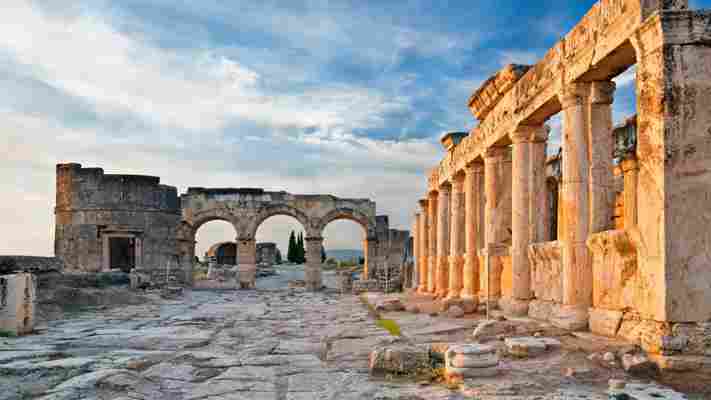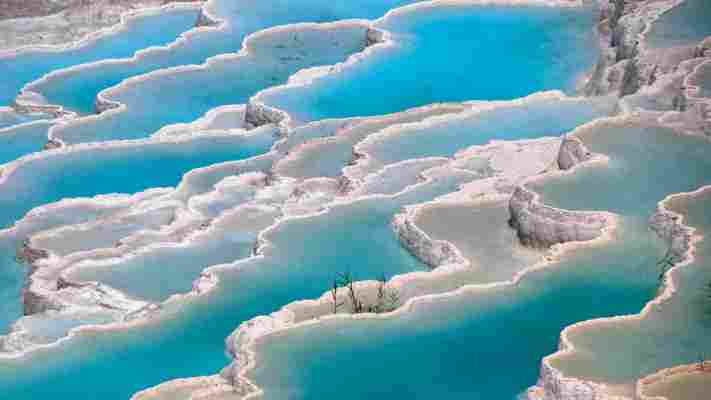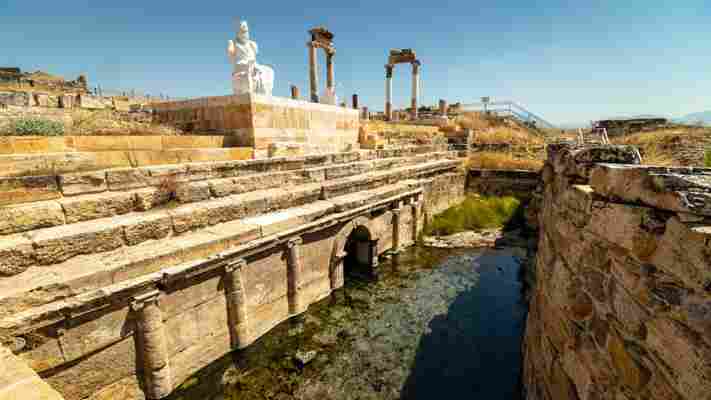In Pamukkale in western Turkey, an enormous white rock formation towers over the surrounding plain. The gleaming mountain of petrified limestone cascades to the valley floor, creased with frozen stalactites and tessellated with hundreds of pools of sparkling turquoise water.

These otherworldly formations are travertines, limestone cliffs slowly created over 400,000 years by the bubbling up of mineral springs. As the water flows down the hillside it degasses, leaving behind a vast deposit of bright white calcium carbonate that's almost 3km long and 160m high. This is not the only place where travertines occur – Huanglong in China and Mammoth Hot Springs in Yellowstone National Park are other famous examples – but the ones at Pamukkale are the largest and arguably the most magnificent in the world. They're one of the country's most popular visitor attractions, and are so spectacular that the Unesco World Heritage Site's name means "cotton castle" in Turkish.
Until the pandemic hit, more than 2.5 million people a year made the journey here from Izmir or Istanbul, spilling out of tour buses at the top of the dazzling plateau and swarming across the landscape like ants on a gigantic mound of sugar before piling back on board and heading on to the beaches of Bodrum or the historic ruins of Ephesus.
But visitors who simply dip their toes in the vivid mineral pools and take a selfie in front of the dripping natural columns before moving on are missing a trick. Because perched at the very top of Pamukkale's white crags sits an even more fascinating attraction: the ruins of the beautiful ancient city of Hierapolis.
Hierapolis was founded by the Attalid kings of Pergamon at the end of the 2nd Century BC before being taken over by the Romans in 133 AD. Under Roman rule, it became a thriving spa town; by the 3rd Century, visitors were coming from all over the Empire to admire the landscape and bathe in the supposedly healing waters. The success of the city is still visible in its impressive arched entrance gate, its colonnaded main street and its beautifully restored amphitheatre, all built from the same local travertine that glows golden in the hot Turkish sun.

Pamukkale's calcite-laden waters have created a surreal landscape of terraced basins and petrified waterfalls (Credit: Feng Wei Photography/Getty Images)
"The thermal waters are likely one of the primary reasons for the city's foundation," said Dr Sarah Yeomans, an archaeologist at the University of Southern California who specialises in the Roman Empire. "By the mid-2nd Century, Hierapolis would have been a beautiful, bustling spa-town with what I imagine was a more dynamic and diverse population than most, given the popularity of such places with visitors."
But Hierapolis was also known throughout the Roman world for another, more sinister reason. It was said to be the location of a "Gate to Hell", a portal to the underworld where the toxic breath of the three-headed hellhound Cerberus flowed out of the ground, claiming unsuspecting victims on behalf of his master, the god Pluto. A shrine – the Ploutonion – was built on the site, and pilgrims travelled from across the region to pay the priests of the temple to make sacrifices to Pluto on their behalf.
You may also be interested in: • The enduring allure of lost cities • The Turkish city that lives for breakfast • The wickedest city on Earth?
Writers of the time, including Pliny the Elder and the Greek geographer Strabo, described these sacrifices as a chilling spectacle. A priest would lead an animal, perhaps a sheep or a bull, into the shrine. As if by the hand of the god, the animal would instantly drop dead, while the priest would walk out alive. "I threw in sparrows, and they immediately breathed their last and fell," wrote Strabo in Book 13 of his encyclopaedia Geography , clearly astonished by what he had just witnessed.
When you visit the Ploutonion today it's hard to imagine these dramatic scenes being real. Now excavated and restored, it's a tranquil place: a rectangular enclosure filled with about 25cm of sparkling clear water topped with gently drifting mineral foam, and a small arched entrance on one side. Above it is stepped seating for spectators, and a replica statue of Pluto gazes benignly down into the arena. When I visited, I couldn't understand how this could be a place of death? Surely these are made-up stories, I thought. How could the priests survive while the animals die?
These were questions that also intrigued Hardy Pfanz, a volcano biologist from Germany's University of Duisburg-Essen who studies geogenic gases – gases given off during geological processes. "When I read the descriptions from the ancient writers, I began wondering if there could be a scientific explanation," he said. "I wondered, could this Gate to Hell be a volcanic vent?"

The Plutonium shrine was constructed at the location of what was thought to be a "Gate to Hell" (Credit: Bella Falk)
Keen to test his theory, Pfanz travelled to Hierapolis in 2013. "We weren't sure what we would find. It could've been made up, could've been nothing," he laughed. "We certainly weren't expecting to get an answer so quickly." But get an answer he did, almost immediately. "We saw dozens of dead creatures around the entrance: mice, sparrows, blackbirds, many beetles, wasps and other insects. So, we knew right away that the stories were true."
When Pfanz tested the air around the vent with a portable gas analyser he discovered the reason: toxic levels of carbon dioxide. Normal air contains just 0.04% CO2 but Pfanz was shocked to discover that the concentration around the shrine reached a staggering 80%. "Just a few minutes exposure to 10% carbon dioxide can kill you," he said, "so the levels here are really deadly."
These ultra-high levels of carbon dioxide are caused by the same geological system that created the area's hot springs and dramatic travertine terraces. Hierapolis is built on the Pamukkale fault, a 35km-long active tectonic fault zone where cracks in the Earth's crust allow mineral-rich water and deadly gases to escape to the surface. One of them runs directly under the city centre and into the Ploutonion.
"Almost certainly the choice of the Ploutonion's location was directly related to the seismic gas vents that exist here," said Yeomans. "Given that the underworld and the deities and myths associated with it were a significant part of their religious ethos, it makes sense that they would construct temples and shrines in places that most evoked the world that they believed lay beneath their feet."
But such proximity to the forces of nature came at a price: an active fault zone also causes earthquakes, which levelled the city in 17 AD, 60 AD, and again in the 17th and 14th Centuries. Eventually, Hierapolis was abandoned.
Visitors from across the Roman Empire came to the spa town to soak in the mineral-rich, geothermal waters (Credit: Sebastian Condrea/Getty Images)
But Pfanz was still mystified by one thing: if this area is so deadly, why did the priests in the Ploutonion not die too? He returned to Hierapolis the following year and this time he studied the concentrations of the gas at different times of the day. "We noticed that during the day, when it's warm and sunny, the carbon dioxide quickly dissipates," he said. "But because carbon dioxide is heavier than air, at night when it's cooler it pools in the arena, creating a lethal lake of gas at ground level."
His conclusion: the animals, with their noses close to the ground, quickly suffocated in this toxic cloud, but the priests, standing taller, were breathing much lower levels of CO2 and were able to survive.
I realised we had solved this ancient mystery; it was a really fantastic feeling
Was this spectacle a massive money-making confidence trick, or did the priests really believe they were communicating with the gods? "There's no question that the Ploutonion in Hierapolis was big business," said Yeomans, "but it's hard to be sure if the priests really understood what was going on. Some may well have attributed their survival to the favour of the divine, while others may have regarded it as a natural – if enigmatic – phenomenon that could be observed and, at least to some extent, predicted."
Today the Ploutonion is bricked up, and a walkway has recently been built around the site to allow visitors a chance to view this legendary arena without getting too close to the source of the deadly gas. But even with these modern trimmings, it's thrilling to be able to walk in the footsteps of the Greek and Roman pilgrims and look down on the place where mythology and reality meet; where the ancient gods reached out and touched the lives of the people.
"When I first recognised that the legendary breath of Cerberus is actually carbon dioxide, I was standing right in front of the archway," said Pfanz. "In that moment, I realised we had solved this ancient mystery; it was a really fantastic feeling."
Pamukkale is one of the country's most popular visitor attractions (Credit: Petekarici/Getty Images)
Join more than three million BBC Travel fans by liking us on Facebook , or follow us on Twitter and Instagram .
If you liked this story, sign up for the weekly bbc.com features newsletter called "The Essential List". A handpicked selection of stories from BBC Future, Culture, Worklife and Travel, delivered to your inbox every Friday.
Leave a Comment